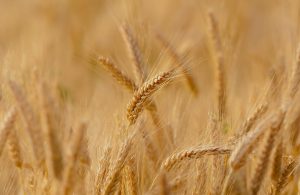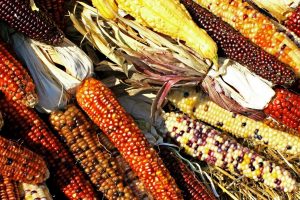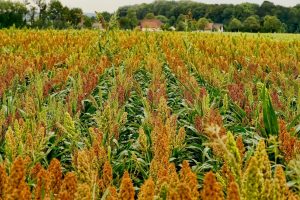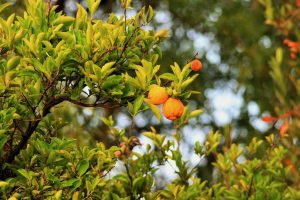Introducing the Future Crops Collection
We are excited to be launching our Future Crops Collection, the result of an interdisciplinary call for papers convened by PLOS ONE and our fabulous team of Guest Editors. The theme of the Collection encompasses a broad range of research aimed at the development and delivery of resilient, climate-smart crops and cropping systems for the 21st century. We are pleased that the Collection features research articles that span a considerable diversity of crop species, geographical locations, and fields of research.
All submitted research was evaluated by the Guest Editors, who have selected articles for inclusion in the Collection. At the time of launch, there are twenty-one research articles featured in the Collection- and discussed below- but more papers will be added as they are published over the coming weeks.
Wheat is the focus of three articles featured in the initial Collection release. In South Africa, Mathew and colleagues used a panel of 100 genotypes to perform a genome-wide association study of drought tolerance and biomass allocation (1). They identified a number of markers for further validation and application in breeding programmes. Meanwhile, in Germany, Dadshani and colleagues evaluated salinity tolerance in lines resulting from back-crossing synthetic hexaploid wheat with an elite winter wheat cultivar (2). The back-crossed lines showed enhanced performance relative to the parents on a range of measures, suggesting potential for application in future breeding for salinity tolerance and other desirable traits. Finally, in Hungary, Balla and colleagues investigated the influence of the timing and duration of heat stress on responses shown by winter wheat cultivars (3). The researchers found substantial heterogeneity in response profiles among cultivars, highlighting the importance of leveraging existing genetic diversity in breeding efforts.
Five studies among the first batch of Collection articles focus on maize. In Brazil, Couto and colleagues looked at whether the F1 or F2 generation represented the better choice for haploid induction, a cornerstone of maize breeding (4). Their results suggest that, for tropical germplasm, the F1 generation showed a superior balance between time saving and genetic variability. Erasmus and colleagues in South Africa introgressed a Bt transgene into an open-pollinated maize variety and quantified the concentration of the defensive Cry1Ab protein accumulated in maize tissues, as well as the survival of maize stalk borer larvae in the transgenic plants (5). They found that introgression of the transgene could produce plant progenies that express Cry1Ab at sufficient concentrations to control pest larvae. In China, Li and colleagues evaluated the utility of fitting large-effect SNPs as fixed effects and including a genotype-by-environment component in modelling genomic selection for developmental traits (6). This approach improved prediction accuracy and could find application in future maize breeding strategies. Cuello and colleagues in France used a multiscale systems approach to examine the genetic basis of maize cell wall degradability (7). Their results shed light on the regulatory mechanisms by which a major locus influences cell wall degradability, and lay the foundations for future engineering of cell wall properties. Finally, Ewing and colleagues in the USA uncovered evidence for a ‘home field advantage’ in maize breeding, whereby genotype-by-environment interactions can be exploited to develop varieties with reliable high productivity in narrow environments (8).
Four articles now available in the Collection investigate rice biology and cultivation. In China, Fang and colleagues analysed the transcriptome of the rice leaf streak pathogen under oxidative stress, finding evidence that key components of the stress response are derived from horizontal gene transfer (9). Working in the USA, Kraus and Stout explored the potential of methyl jasmonate seed treatment for the induction of resistance to rice water weevil (10). They found that the treatment was effective, despite some reductions in plant growth. In Japan, Ogawa and colleagues demonstrated the potential of unmanned aerial vehicles and image analysis to quantify rice plant architecture under field conditions (11). Meanwhile, in Germany, Bierschenk and colleagues screened rice wild relative genotypes for tolerance to iron toxicity (12). They uncovered significant levels of variation in tolerance among genotypes, suggesting potential for the use of interspecific crosses to produce more stress-resilient cultivars.
Two other cereal crops appear in the first batch of Collection articles. Sakamoto and colleagues, working in Japan, compared the effect of shape quantification method selection on the results of genomic prediction and genome wide association studies of seed morphology in sorghum (13). They found that choice of direction and scaling standardisation procedures affected the results of the analyses. Meanwhile, in the USA, Palmer and colleagues compared the transcriptomes of two switchgrass cultivars during leaf development (14). Their results highlight differences between cultivars in the expression of genes encoding proteins involved in environmental signal transduction.
Fruit crops are the focus of three articles highlighted in the Collection. In Canada, Marty and colleagues looked at the impact of competition from weeds on blueberry growth and fruit yield under different nitrogen fertilisation regimes (15). They concluded that inorganic nitrogen fertilisers were most effective at improving yield, but that this effect was mediated by the identity and density of neighbouring weeds. In the USA, Hendrickson and colleagues found evidence for pre-climacteric activation of alternative oxidase transcription in pear fruit during cold-induced ripening (16). Finally, in Spain, Garmendia and colleagues performed a systematic review of studies of role of gibberellic acid in citrus flowering and fruiting, finding strong evidence in support of a number of hypotheses (17).
Many other crop species are also represented in the Future Crops Collection. In the UK, Huang and colleagues found that a quantitative trait locus (QTL) for resistance against fungal blackleg infection in leaves of young oilseed rape plants overlapped with a QTL for quantitative resistance in stems of adult plants (18). Meanwhile, in Bhutan, Katwal and Bazile performed the first trials of quinoa varieties in the Himalayan context (19). They describe the potential for quinoa production in the country’s mountainous environments, and initiatives underway to promote its adoption. In the USA, Sharpe and colleagues investigated the effects of organic and conventional fertilisers on the phytonutrient and transcriptomic profiles of tomato fruit and leaf tissues (20). They found evidence for transcriptional and metabolic adaptation to the different fertiliser regimes, with implications for future breeding strategies.
Finally, one paper featured in the first batch to be highlighted in the Collection focuses on the contribution of crop diversification to agricultural intensification in India during recent decades (21). Smith and colleagues emphasised the importance of considering multiple spatial scales when analysing changes in crop diversity and production through time, with important lessons for modelling future trends.
The breadth of research submitted to our Future Crops call for papers meant that we relied on the time and expertise of many members of PLOS ONE’s editorial board for this project, and we extend our sincere thanks to them for all their invaluable contributions.
If you’re interested in keeping up to date with the latest research in Crops, Food Security and Food Systems, check out our PLOS Channel. Keep an eye out too for an exciting announcement about a new PLOS ONE Collection on plant phenotyping, with a Call for Papers to be launched in the coming weeks!
About the Guest Editors
Gert Kema
Gert Kema has 33 years of experience in plant pathology, host and pathogen genetics and genomics, specializing in foliar diseases of cereals and banana. Since five years major lead of international programs on Fusarium wilt in banana. Published over 100 peer reviewed scientific articles, holder of patents and international speaker. Interests are plant diseases (in the tropics) and their management and food security. He obtained a BSc degree in agronomy and a MSc in plant breeding. He obtained his PhD in 1996 on research into Zymoseptoria tritici, the Septoria tritici blotch fungus of wheat. Currently he also holds a special chair as professor of tropical plant pathology and heads the Department of Phytopathology at Wageningen University, The Netherlands. His research focus is currently on banana and the fungal pathogens causing Panama disease (Fusarium spp.) and Black Sigatoka (Pseudocercospora fijiensis). He is a co-founder of three companies related to banana crop and cultivation innovation. Dr Kema is also a Channel Editor for the PLOS Crops, Food Security and Food Systems Channel.
Lee Hickey
Dr Lee Hickey is a Senior Research Fellow and ARC DECRA Fellow at The University of Queensland in Australia who conducts discovery and applied research on major food crops like wheat and barley. This includes the genetic dissection of key traits that limit productivity on farms and the development of novel technologies to assist plant breeders. Dr Hickey has played a pivotal role in developing crop ‘speed breeding’ technology for rapid generation advance, which enables growing up to six generations of major crops per year and dramatically reduces the length of the breeding cycle. Speed breeding is adopted by research institutes and companies around the world and is fast-tracking development of more productive and robust crop varieties for farmers. For his speed breeding innovation, Dr Hickey was awarded the 2017 Queensland Young Tall Poppy Scientist of the Year. He is passionate about training the next generation of plant breeders and communicating plant science to the broader community.
Sean Mayes
Sean Mayes BA (Hons), PhD, is an Associate Professor in Crop Genetics in the University of Nottingham and Theme Leader/Mentor with Crops For the Future in Malaysia. He joined the University in 2004 and was made an Associate Professor in 2008. During a leave of absence between 2012 and 2015 he was based in Malaysia while helping to establish Crops For the Future as a programme and theme leader. He still runs research groups in both UK and CFF, as well as collaborating with researchers at the University of Nottingham Malaysia Campus and is co-director of the CFF-UNMC-Doctoral Training Partnership. His research interests are focused around the use of marker assisted selection within crop species and he has research in wheat, oil palm and a number of minor or underutilised crops, including bambara groundnut; an African drought tolerant legume. He has developed and applied genetic markers to a wide range of species (including studying population structures within insect populations) and many tropical crop species. In 2016 he took over the chief editor position for Biotechnology and Genetic Engineering Reviews and has just co-edited a comprehensive book on oil palm breeding, genetics and. To date, he has published over 100 peer reviewed journal articles.
Rob Sharwood
Dr Sharwood completed his PHD at ANU in 2006 in Plant Sciences and then moved to the Boyce Thompson Institute at Cornell University to understand the intricacies of chloroplast gene regulation. In 2010 he returned to the Hawkesbury Institute, UWS to continue an independent photosynthesis research program focusing on C4 grasses, Eucalypts and Cotton. Currently, he is a Senior Lecturer within the ARC Centre of Excellence for Translational Photosynthesis at the Research School of Biology, ANU. The overarching theme of his research is to improve plant productivity under future climates. This will be achieved by deciphering chloroplast gene regulatory mechanisms critical for engineering chloroplasts. The second theme of his research is to understand the adaptive evolution of Rubisco catalysis within food and fibre crops to provide the next generation solutions for tailoring CO2 fixation to variable future climate conditions. He also works within the Cotton Industry to translate fundamental research into future cotton crops to improve resource use and mitigate climate extremes. Dr Sharwood is also a Channel Editor for the PLOS Crops, Food Security and Food Systems Channel.
Zerihun Tadele
Dr Tadele is Group Leader at the Institute of Plant Sciences, University of Bern in Switzerland and Adjunct Associate Professor at Addis Ababa University, Institute of Biotechnology in Ethiopia. He is also a member of CDE (Centre for Development and Environment) at the University of Bern. He received PhD from the University of Basel and habilitation from the University of Bern. He is interested in contributing to global food security through improving productivity of orphan crops from the developing world. His current research focuses on tef (Eragrostis tef), an important indigenous cereal in the Horn of Africa which is annually cultivated on over three million ha of land and is a staple food for over 60 million people in Ethiopia alone. Tef is a versatile crop which performs better than most other cereals under extreme climatic and soil conditions. It is also considered as a life style crop due to its nutritional- and health-related benefits. Using genetic and genomic tools, his group focuses on tackling major yield limiting factors in tef. Dr Tadele’s group closely works with the Ethiopian Agricultural Research System in developing and disseminating improved tef varieties to farmers. Dr Tadele is also a Channel Editor for the PLOS Crops, Food Security and Food Systems Channel.
Sieglinde Snapp
Sieglinde Snapp is a Professor of Soils and Cropping Systems Ecology and Associate Director of the Center for Global Change and Earth Observations, Michigan State University. She has been a member of the American Society of Agronomy and Soil Science Society of America since 1983, was elected a fellow in 2010, awarded the International Service Award in 2015, and Fulbright Fellowships in 2009 and 2016. She has published two text books, 128 journal articles and dozens of extension bulletins as well as an innovative learning lab website for sustainable land management and food security in Africa.She carries out participatory action research and extension in Malawi and the region, to support co-generation of agronomic knowledge, and disseminate. Her highly collaborative approach to sustainable systems science has brought to the world’s attention the inadvertent negative consequences, tradeoffs and synergies of sole versus diversified cropping, and the urgent need for biologically sound soil and crop management. She co-edited the text book ‘Agricultural Systems’ and is ‘Mother of the Mother and Baby Trial Design’, used in over 30 countries by agricultural scientists to communicate with farmers and extension educators, in support of relevant, adaptive research. Open science to engage stakeholders in agricultural systems design is her current focus, as a key component of contested agronomy approaches to sustainable agriculture.
Olivia Wilkins
Olivia Wilkins leads the Plant Systems Biology research group at McGill University. She received her PhD from the University of Toronto in 2010. From 2011 to 2015, she was an NSERC postdoctoral researcher at the Centre for Genomics and Systems Biology at New York University where she collaborated extensively with scientists at the International Rice Research Institute. In 2015, she was a Visiting Scientist at the Broad Institute of Harvard and MIT. In 2013, she was awarded a Basic Research to Enable Agricultural Development Award from the Bill & Melinda Gates Foundation. Her lab studies the effect of water and temperature extremes on early development of cereal crops. She is particularly interested in regulatory network prediction and the interplay between episodic stressors and photoperiod. Her research group will be moving to the University of Manitoba in July 2019.
Kate Tully
Dr Kate Tully is the Assistant Professor of Agroecology in the Department of Plant Science and Landscape Architecture at the University of Maryland. She earned a bachelor’s degree in English, Spanish, and Biology from Kenyon College and a master’s and doctorate in Ecology from the University of Virginia. She conducted her postdoctoral research at Columbia University’s Earth Institute, where she studied the environmental impacts of the African Green Revolution. Her research assesses the sustainability of food production systems by examining how they affect the interactions between plants, soils, carbon, nutrient, and water cycles.
Sophien Kamoun
Sophien Kamoun grew up in Tunisia where he developed a passion and curiosity about nature. He studied genetics in Paris and Davis, California, before working in Wageningen, Ohio and Norwich, where he is currently a Senior Scientist at The Sainsbury Laboratory and Professor of Biology at The University of East Anglia. He is known for his seminal contributions to our understanding of plant diseases and plant immunity. Professor Kamoun pioneered genomics and molecular biology methods to reveal fundamental insights into the biology and evolution of eukaryotic plant pathogens. He discovered virulence effector families from pathogenic oomycetes and fungi, and showed how they can modulate plant immunity. He demonstrated how antagonistic coevolution with host plants has impacted the architecture of pathogen genomes, accelerated the evolution of effector genes, and drove the emergence of immune receptors networks. His inventive work in plant pathology has resulted in new approaches to mitigate some of the world’s most serious crop diseases. Professor Kamoun has received many awards and recognitions, notably the Kuwait Prize and The Linnean Medal.
References
- Mathew I, Shimelis H, Shayanowako AIT, Laing M, Chaplot V (2019) Genome-wide association study of drought tolerance and biomass allocation in wheat. PLoS ONE 14(12): e0225383. https://doi.org/10.1371/journal.pone.0225383
- Dadshani S, Sharma RC, Baum M, Ogbonnaya FC, Léon J, Ballvora A (2019) Multi-dimensional evaluation of response to salt stress in wheat. PLoS ONE 14(9): e0222659. https://doi.org/10.1371/journal.pone.0222659
- Balla K, Karsai I, Bónis P, Kiss T, Berki Z, Horváth Á, et al. (2019) Heat stress responses in a large set of winter wheat cultivars (Triticum aestivum) depend on the timing and duration of stress. PLoS ONE 14(9): e0222639. https://doi.org/10.1371/journal.pone.0222639
- Couto EGdO, Cury MN, Bandeira e Souza M, Granato ÍSC, Vidotti MS, Domingos Garbuglio D, et al. (2019) Effect of F1and F2 generations on genetic variability and working steps of doubled haploid production in maize. PLoS ONE 14(11): e0224631. https://doi.org/10.1371/journal.pone.0224631
- Erasmus R, Pieters R, Du Plessis H, Hilbeck A, Trtikova M, Erasmus A, et al. (2019) Introgression of a cry1Abtransgene into open pollinated maize and its effect on Cry protein concentration and target pest survival. PLoS ONE 14(12): e0226476. https://doi.org/10.1371/journal.pone.0226476
- Li D, Xu Z, Gu R, Wang P, Lyle D, Xu J, et al. (2019) Enhancing genomic selection by fitting large-effect SNPs as fixed effects and a genotype-by-environment effect using a maize BC1F3:4 PLoS ONE 14(10): e0223898. https://doi.org/10.1371/journal.pone.0223898
- Cuello C, Baldy A, Brunaud V, Joets J, Delannoy E, Jacquemot M-P, et al. (2019) A systems biology approach uncovers a gene co-expression network associated with cell wall degradability in maize. PLoS ONE 14(12): e0227011. https://doi.org/10.1371/journal.pone.0227011
- Ewing PM, Runck BC, Kono TYJ, Kantar MB (2019) The home field advantage of modern plant breeding. PLoS ONE 14(12): e0227079. https://doi.org/10.1371/journal.pone.0227079
- Fang Y, Wang H, Liu X, Xin D, Rao Y, Zhu B (2019) Transcriptome analysis of Xanthomonas oryzaeoryzicola exposed to H2O2 reveals horizontal gene transfer contributes to its oxidative stress response. PLoS ONE 14(10): e0218844. https://doi.org/10.1371/journal.pone.0218844
- Kraus EC, Stout MJ (2019) Seed treatment using methyl jasmonate induces resistance to rice water weevil but reduces plant growth in rice. PLoS ONE 14(9): e0222800. https://doi.org/10.1371/journal.pone.0222800
- Ogawa D, Sakamoto T, Tsunematsu H, Yamamoto T, Kanno N, Nonoue Y, et al. (2019) Surveillance of panicle positions by unmanned aerial vehicle to reveal morphological features of rice. PLoS ONE 14(10): e0224386. https://doi.org/10.1371/journal.pone.0224386
- Bierschenk B, Tagele MT, Ali B, Ashrafuzzaman Md, Wu L-B, Becker M, et al. (2020) Evaluation of rice wild relatives as a source of traits for adaptation to iron toxicity and enhanced grain quality. PLoS ONE 15(1): e0223086. https://doi.org/10.1371/journal.pone.0223086
- Sakamoto L, Kajiya-Kanegae H, Noshita K, Takanashi H, Kobayashi M, Kudo T, et al. (2019) Comparison of shape quantification methods for genomic prediction, and genome-wide association study of sorghum seed morphology. PLoS ONE 14(11): e0224695. https://doi.org/10.1371/journal.pone.0224695
- Palmer NA, Chowda-Reddy RV, Muhle AA, Tatineni S, Yuen G, Edmé SJ, et al. (2019) Transcriptome divergence during leaf development in two contrasting switchgrass (Panicum virgatum) cultivars. PLoS ONE 14(9): e0222080. https://doi.org/10.1371/journal.pone.0222080
- Marty C, Lévesque J-A, Bradley RL, Lafond J, Paré MC (2019) Lowbush blueberry fruit yield and growth response to inorganic and organic N-fertilization when competing with two common weed species. PLoS ONE 14(12): e0226619. https://doi.org/10.1371/journal.pone.0226619
- Hendrickson C, Hewitt S, Swanson ME, Einhorn T, Dhingra A (2019) Evidence for pre-climacteric activation of AOX transcription during cold-induced conditioning to ripen in European pear (Pyrus communis). PLoS ONE 14(12): e0225886. https://doi.org/10.1371/journal.pone.0225886
- Garmendia A, Beltrán R, Zornoza C, García-Breijo FJ, Reig J, Merle H (2019) Gibberellic acid in Citrus flowering and fruiting: A systematic review. PLoS ONE 14(9): e0223147. https://doi.org/10.1371/journal.pone.0223147
- Huang Y-J, Paillard S, Kumar V, King GJ, Fitt BDL, Delourme R (2019) Oilseed rape (Brassica napus) resistance to growth of Leptosphaeria maculansin leaves of young plants contributes to quantitative resistance in stems of adult plants. PLoS ONE 14(9): e0222540. https://doi.org/10.1371/journal.pone.0222540
- Katwal TB, Bazile D (2020) First adaptation of quinoa in the Bhutanese mountain agriculture systems. PLoS ONE 15(1): e0219804. https://doi.org/10.1371/journal.pone.0219804
- Sharpe RM, Gustafson L, Hewitt S, Kilian B, Crabb J, Hendrickson C, et al. (2020) Concomitant phytonutrient and transcriptome analysis of mature fruit and leaf tissues of tomato (Solanum lycopersicum L. cv. Oregon Spring) grown using organic and conventional fertilizer. PLoS ONE 15(1): e0227429. https://doi.org/10.1371/journal.pone.0227429
- Smith JC, Ghosh A, Hijmans RJ (2019) Agricultural intensification was associated with crop diversification in India (1947-2014). PLoS ONE 14(12): e0225555. https://doi.org/10.1371/journal.pone.0225555






